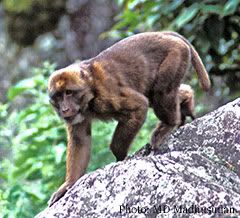
E: Environment, Enrichment,
Education, & Endangered Species
All content © by Diana L. Guerrero unless otherwise noted and may not be reprinted without prior written permission. All rights reserved. Click here for reprint permissions and fees.
The Arunachal macaque (Macaca munzala) is our feature animal. The newly discovered Arunachal macaque (Macaca munzala) is an old world monkey. Not much is known yet as the discovery was just announced in December of 2004. Keep your eyes open for the report in the International Journal of Primatology. new primate species discovered in Northeast India is relatively large. These macaques have shorter tails than other primates of their size. The Arunachal macaques are one of the highest altitude dwelling primates in the world living between 5,250 and 11,500 feet above sea level.
Animal of the Month
Arunachal Macaque (Macaca munzala)
Recent expeditions into Arunachal
Pradesh also discovered the leaf deer (Muntiacus putaoensis),
and the black barking deer (Muntiacus crinifrons) and the
Chinese goral (Nemorhaedus caudatus).
A new species of macaque, previously unknown to science, has been discovered in western Arunachal Pradesh in India (near Bhutan). The new species of macaque was observed and photographed by the scientists during expeditions undertaken in 2003 and 2004 by the Mysore based Nature Conservation Foundation (NCF), the Wildlife Conservation Society (WCS, New York), the International Snow Leopard Trust (ISLT, Seattle) and the National Institute of Advanced Studies (NIAS, Bangalore).
Funded by the Van Tienhoven Foundation (The Netherlands), and the Rufford Maurice Laing Foundation (UK), the expeditions were carried out with local support from the Arunachal Pradesh Forest Department.
Called the Arunachal macaque (Macaca munzala), the species is suspected to be a close cousin of both the Assamese macaque and the Tibetan macaque. Macaque munzala troops were found dispersed over an area of 1,200 square kilometres and all closely resemble the others.
Distinguishing features include a characteristically dark face with unique facial markings, and a tail length intermediate between the Assamese and Tibetan macaque. The species also lives at between 5,250 and 11,500 feet above sea level and is considered to be one of the highest altitude dwelling primate species in the world.
Macaques are a large, diverse group of Old World primates (19 species in Asia, 1 in Africa). The last discovery of a new macaque species occurred in 1903. (102 years ago the Pagai macaque was described by Miller.)
This unexpected discovery of a new primate species was made by Dr. Anindya Sinha, Dr. Aparajita Datta, Dr. M.D. Madhusudan and Dr. Charudutt Mishra. The macaque species scientific name originates from the Dirang Monpa language, "mun zala" (deep forest monkey).
Ongoing studies will examine the behavior and ecology of this species, as well as survival threats. Work in the high altitude areas of Arunchal Pradesh has also led to the creation of the Tsangyang Gyatso Biosphere Reserve by the Arunachal Pradesh government. The area is considered one of India’s last unexplored frontiers.
New scientific discoveries are important windows into the world's astounding biodiversity. We don't know it all...Nature Conservation Foundation researchers Samraat Pawar and Aysegul Birand recently reported at least seven new amphibian and reptile species.
About the columnist: Since 1978 Diana L. Guerrero has worked professionally with both wild and domestic animals. Guerrero has been affiliated with, and certified by, a variety of animal programs in the USA and Europe. Based in California, she writes, consults, and speaks. Information on her animal career programs, training courses, and her books {What Animals Can Teach Us about Spirituality (SkyLight Paths, 2003), Blessing of the Animals (Sterling, 2007), Help! My Pet is Driving Me Crazy (Guerrero Ink, 2007), Animal Disaster Preparedness for Pet Owners & Pet Professionals (Guerrero Ink, 2007)} can be found in this web site and in the shop. Questions for Guerrero should be submitted via the blog comments or membership forum.





